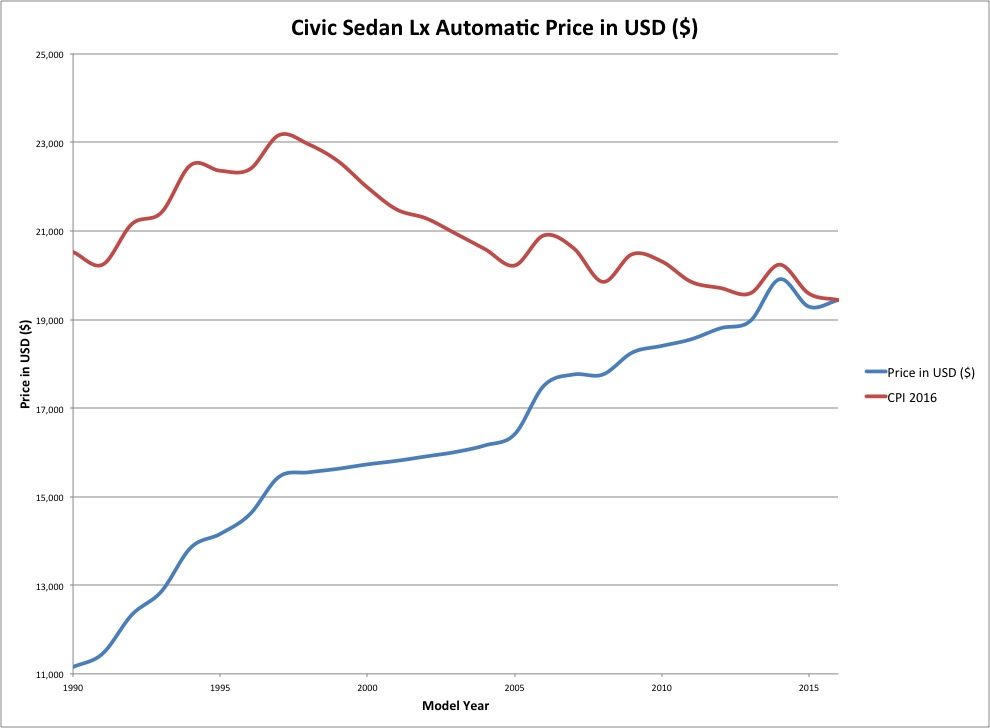Today were going to talk numbers, and I don’t mean horsepower or top speed, but rather inflation’s impact on new car prices. And even though a 707 horse power Dodge Challenger sounds a lot cooler than the Consumer Price index’s impact on car prices, one will affect every car purchase you make and the other will oversteer into a tree.
Although growing MSRPs may lead you to believe new cars are getting more expensive every year, a quick economic analysis shows the contrary, when adjusted for inflation the average cost of a new car is the lowest its been in history. New car MSRPs may climb every year, but once adjusted for inflation its clear we are living in the golden age of the affordable automobile.
Before we dive deeper into this topic were going to have to learn a little economics. That way I can justify my business degree, and you can say you learn something new today. When measuring the true cost of products, economists use the Consumer Price Index or, CPI. This measure uses a standard market basket of goods and services to determine the cost of something from the past in today’s money. When we apply this concept to the prices of cars we get a clear picture of what MSRPs from the past would be in today’s money.
To get a general sample of the price of new cars I chose the most average car I could think of, the Honda Civic Lx Automatic. This ambiguous compact family sedan offers competitive features, and is a staple among American car shoppers making this the perfect car to study.
When we look at the below chart of the Honda Civic’s growing MSRP it’s easy to assume the Civic is far more expensive now than when the chart begins in 1990. The MSRP has grown over $10,000 since 1990, and continues an upward trend as the years progress. However, a chart like this only tells part of the story, when we add in the price of a Civic Adjusted for inflation the numbers show a very different result.

Once we introduce the inflation adjusted price shown in red in the chart below we can start to gain a better understanding of the situation. The growing MSRP of the Civic gives the illusion of a more expensive car, but inflation adjusted prices prove the contrary. Today’s Honda Civic LX is the least expensive its been in history and continues to drop in cost every year. In fact when adjusted for inflation today’s Civic , with a back up camera and heated seats, is $1,000 less than the 1990 model.

This drop in cost of a new Civic is even more incredible when you factor in the changes made to the car over the last 25 years. Today’s Honda civic features things that were science fiction during the production of the 1990 Civic, and is an all around better car. The 2016 Honda Civic has 60 more horse power than the 1990 model while returning 9 miles per gallon better on the highway. It also offers families with far more interior room and a much higher level of safety. Its like comparing the iPhone 7 to a flip phone, sure they do the same basic job, and one has a head phone jack, but the progress is undeniable.
Today the average MSRP of a new car is $31,252 which seems like a lot but when we adjust it for inflation the reality of this number shines through. The below graph overlays the average cost of a new car when adjusted for inflation with the data of the Civic LX study to demonstrate that the Civic is not an outlier, and conforms to the trends of average car pricing. Minus the dip in price during the 2008 financial crisis, we can see that new car prices have been on the decline since the late 1990s.
When we look at the situation in terms of inflation we can finally grasp the true state of the new car market. Although new cars may seem more expensive thanks to higher MSRP’s, we now know they are far more affordable today. The features and safety new cars can offer at a similar cost in today’s world is absolutely astonishing, and when we look past MSRP we can now see they are better deal than anything in history.





Leave a reply